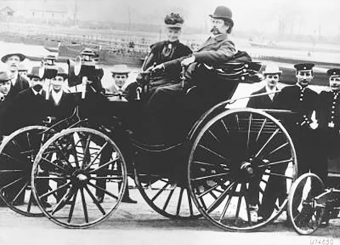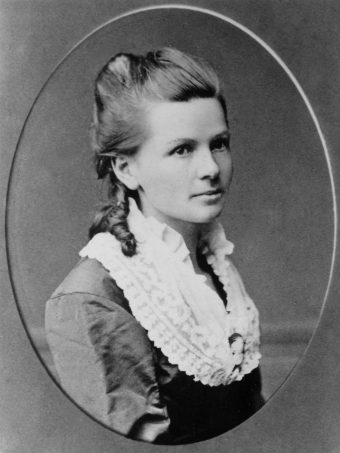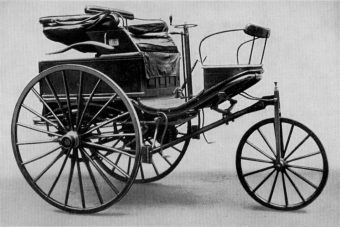
As with many inventions, Benz's Motorwagen wasn't a design that just came out of nowhere. It was a product of innovation-evolution, simply the next iteration of a long line of previous inventions. Perhaps the first vision of a horseless, mechanical cart came from Leonardo da Vinci in 1479. Titling it "Design for Spring-Driven Car or Horseless Wagon," there's no proof he actually built it but his sketch looks like a spring-loaded tricycle. A few hundred years later, steam engines were also used in attempts to replace the horse-drawn carriage.
In 1769, Frenchman Nicolas-Joseph Cugnot constructed what is regarded as the first working self-propelled vehicle intended for human travel. Essentially a large steam-powered tricycle, its top speed was slower than a brisk walk (about two miles an hour). This doesn't include the four or five times it needed to stop per hour for water refill and to allow the steam pressure to build back up. Needless to say, this was not practical.
Six decades later, Scotsman Robert Anderson put a non-rechargeable battery on a carriage and it moved…albeit not very fast and for very long. Fellow countryman Robert Davidson expanded on this innovation, creating a battery in 1841 that could propel a carriage to go 1.5 miles in less than thirty minutes. Then, unfortunately, it needed a new battery. While several advancements were made on the electric car front (see: That Time in 1899 When Ninety Percent of New York City's Taxi Cabs Were Electric Vehicles and The First Gas / Electric Hybrid, Built in 1900), for various reasons it wouldn't be until the 21st century that we have finally gone full circle and started coming up with commercially viable electric cars, with cars such as the Nissan Leaf, Chevy Bolt, and Tesla Model S, Model X, and Model 3, the last of which shares the name of the car we'll be discussing today.
This brings us to the internal combustion engine, which, much like the automobile, has its own evolutionary history. The first combustion engines didn't take advantage of any sort of internal compression and weren't particularly powerful or practical. In 1806, Swiss engineer François Isaac de Rivaz was the first to construct an internal combustion engine that used hydrogen and oxygen. More explosive, it did at least provide the germ of an idea for several other inventors and their inventions, including Jean Joseph Etienne Lenoir's "Hippomobile." Considered the first successful horseless carriage powered by an internal combustible engine, it was patented by Lenoir in 1860 and looks more ship-like than car. American George Brayton was the first to develop a kerosene-fueled engine in 1873, but that also didn't provide enough power for a commercially viable automobile. 12 years later, Benz used these previous innovations to influence his own design for what is generally c onsidered the first "modern" automobile.
Born in the southwest German city of Karlsruhe in 1844, Karl Benz's father died in a railway accident when he was only two years old. Despite being poor, his mother made sure his education got top priority, rather than sending him off to work in some factory or the like as so many others in such situations had to do. Always a scientific-minded student who loved riding his bicycle (a relatively new invention at the time), he entered the University of Karlsruhe at 15 years old. He graduated in July 1864 and began seven long years working various jobs at mechanical engineering companies. Eventually he saved enough money to open his own iron construction business with a business partner, August Ritter. Almost immediately the company started going down the toilet, largely thanks to issues with Ritter. Benz was on the verge of bankruptcy when he met Bertha Ringer.

As an unmarried woman of privilege, she was awarded a rather large dowry that was to be relinquished to her husband upon marriage in order that she might continue to lead her accustomed affluent lifestyle – but until that time, it was hers to manage how she saw fit. Now, it is unclear how Karl and Bertha met, but it's very evident that they had a special relationship. In 1870 – two years before they married – Bertha chose to invest a significant amount of her dowry in Benz's business to help ensure his company's financial survival. While this kept the business afloat, unfortunately, due to various issues with other shareholders and Benz' role in the company ultimately becoming marginalized, he was forced to leave this business. But thanks to the rest of Bertha's dowry, he was able to start a new company, Benz & Cie.
Now without interference from shareholders or business partners, Benz began working on whatever pleased him. And what pleased him was engineering several components that today are associated with modern-day vehicles. He then patented these devices and sold the patents to subsidize his other inventing. These included patents for a throttle system, battery-powered ignition systems, spark plugs, gear shifters, carburetors, the water radiator, and the clutch.
A commonly told legend has it that, looking for a distraction one day, Benz visited a nearby bicycle shop to indulge his lifelong passion for the two wheeler. He, instead, became inspired that day and went back into his shop and invented a new type of human transportation device. In truth, Benz, and many others, had long been seeking to create such a device and he had devoted much of his professional life to inventing and improving upon the necessary mechanisms to make such a vehicle possible. It took several years of tinkering, but in January of 1886, he was able to patent his "Motorwagen" – a three-wheeled vehicle with a one-cylinder, four-stroke gasoline engine. While others, such as Gottlieb Daimler, were independently working on essentially the same thing with similar success, it was the Motorwagen that is credited as the world's first practical, commercially available, internal combustion engine powered automobile.

Knowing her husband's lack of confidence and perfectionism all-to-well, and frightened that his invention would end in the dustpan of history, Bertha decided to take matters into her own hands.
It was in August of 1888 when Bertha decided to execute her plan. Awaking early in the morning, she and two of her teen sons, Eugen and Richard, pushed the so-called Motorwagen Model 3 out of her husband's workshop and far enough away where it could be started without waking him up. The purpose of the little joyride she had planned was to visit her mother in Pforzheim, 65 miles away. In the process, she hoped to drum up a considerable amount of publicity, doing something that had never been tried before- taking an automobile on a road trip. Bertha did not inform Karl of this adventure beforehand, but rather left him a note that he discovered when he woke up. Unfortunately for history buffs the world-over, exactly what this note said has been lost to history.
The road to Pforzheim was certainly less-traveled, rocky and unpaved in many places. (Aside: the poem The Road Not Taken probably doesn't say what you think it says, see Robert Frost's Commonly Misinterpreted "The Road Not Taken" and the Role it Played in the Death of His Best Friend) Despite the driving conditions, Bertha was determined, driving and repairing the car on the way. She and her sons had to push the car up many of the hills (which later led her to suggest that the Model 3 needed a lower gear as the 2.5 horsepower engine simply wasn't sufficient for hill climbing).
She also had to stop for fuel at pharmacies that sold ligroin and was forced to make an emergency repair to the car's ignition using, of all things, her garter to insulate a shorted wire. When the fuel line became clogged, she identified the problem and cleared it with her hairpin. When the drive chain broke, she found a blacksmith and instructed him on how to make the needed repair. When the wooden brakes began to crack in the face of sustained downhill usage, she came up with the idea of putting leather on the wooden shoes- the world's first automobile brake pads- finding a shoemaker to provide and attach leather soles for this function. (Along with adding the extra gear and certain minor tweaks based on his wife's feedback, this was another improvement Benz would immediately add to the Model 3's design upon Bertha's return.)
At dusk, Bertha Benz arrived at her mother's home, having made the 65 mile trip, repair time included, in less than 12 hours. All along the way, excited villagers and bystanders witnessed the marvel that was the Motorwagen – sure, it wasn't perfect, but it moved relatively fast and it was safe. She sent a telegram to her husband to tell him of the successful journey, but he already knew due to the significant publicity that echoed across the region thanks to her audacious road trip. Bertha had saved him before with her money- this time she did it with her gumption and faith that his invention could do what no others like it had ever done.
After several days at her mother's, Bertha and the boys returned home in the Motorwagen, this time intentionally going in a different direction, impressing even more people with the Model 3. All in all, it was the world's first automobile road trip- 120 miles in less than 24 hours of driving, including repair and refueling time. Prior to this, the only other known internal combustion automobiles hadn't managed more than a mile, and often had to be returned by rail, pushed, or pulled by horses after having broken down.
Directly after this well publicized road trip, orders started coming in for Benz' Motorwagen. By the end of the century, Benz' company was producing hundreds of cars per year and was the largest automobile manufacturer in the world.
While Karl Benz was a phenomenal engineer and visionary, history almost certainly only remembers him, instead of so many others that were inventing virtually the same thing around this same time, because of the constant financial support and later keen promotional sense of his wife, Bertha Ringer Benz. Once again, as the man himself said, "Only one person remained with me in the small ship of life when it seemed destined to sink. That was my wife. Bravely and resolutely she set the new sails of hope."
If you liked this article, you might also enjoy subscribing to our new Daily Knowledge YouTube channel, as well as:
Bonus Fact:
Expand for ReferencesSource: The Husband and Wife Team That Gave the World the First Car, and the First Road Trip That Saved It From Obscurity
No comments:
Post a Comment